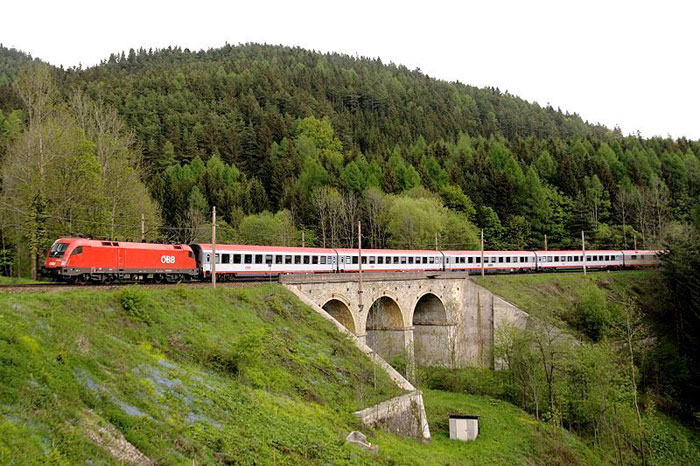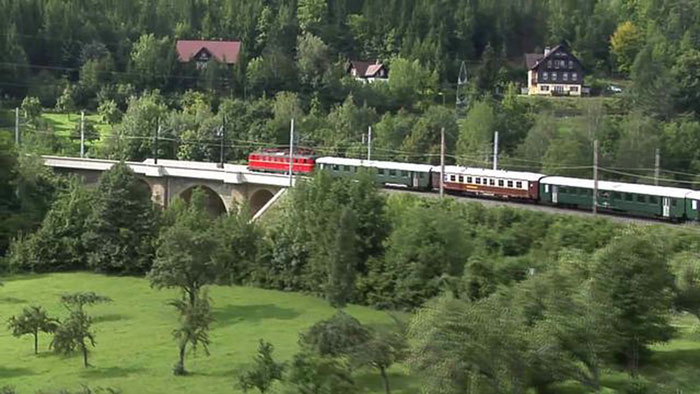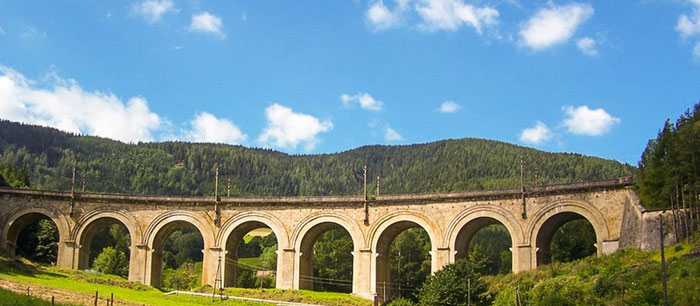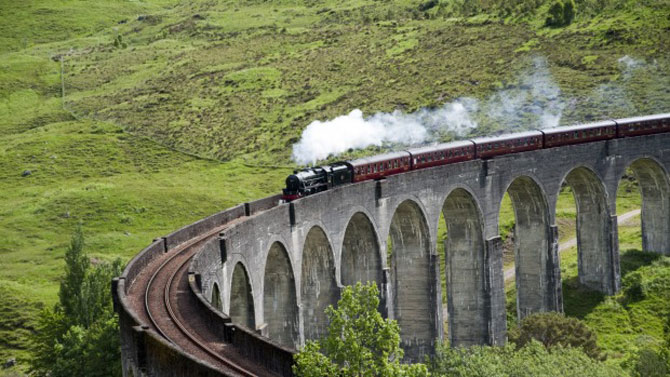Semmering railway route
Unesco, the Scientific, Educational and Cultural Organization of the United Nations, launched the Semmering Railway of Austria as a World Cultural Heritage in 1998.

The Semmering railway starting from Gloggnitz running through Semmering to Muzzuschlag is the world's first mountain railway . The special thing is that this railway also runs through a very difficult terrain with a large difference in height. So far this is the first European railway to be built and still in operation. This railway was built for the purpose of connecting traffic between the capital of Vienna and the important city of Austria-Hung Trieste.

In 1840, due to military and commercial reasons, the Austrian Government wanted to build a railway connecting Vienna with the port city of Trieste and Milano (Italy). In 1842, the railway from Vienna to Gloggnitz was opened. In 1844 - 1846, the route from Muzzuschlag to Maribor passed through Graz. The missing road between Glooggnitz and Muzzuschlag due to the high terrain should be forced through the Semmering Pass .

This railway was designed and built by Italian engineer Carl Ritter von Ghega , who also undertook the construction of this route. The rugged terrain of many bends was used by architect Carl Ritter von Ghega to build viaducts and tunnels. The railway was built in 6 years from 1848 to 1854, the number of workers serving this project was 20,000 workers.

Total Semmering railway is 41 km long, through the height difference of 460 meters with 14 tunnels and 16 viaducts. In which the main tunnel is 1,431m long, more than 100 curved bridges built of stone and 11 small iron bridges. 60% of the length of this railway is sloping 20-25% and almost all roads are curved. The walls throughout the railway through the stations are built of stone, mainly from the main excavation of the tunnels here.

At the time of construction of this railway, the technique applied to build Semmering railway is the most advanced. Engineers have applied new research methods as well as modern tools to build this historic railway. In order to climb the steep slopes, a completely new tractor head was called, Engerth , the name of this locomotive named after its inventor Wilhelm von Engerth . The fuel tank was placed right in the engine head so that the weight of the fuel and water pressed on the wheels, making the wheels stick more firmly to the rail. When the First World War broke out, this railway was suspended and not used for a period of time.

In Austria, almost all railroads are used for traffic on both the left and right sides. The reason for that was because it was in Austria in the left hand drive, after merging into the Nazis, the steering wheel changed to the right. However, this conversion is not done properly, so there is traffic both left and right. When Semmering is completed, the steering part is placed on the left. In 1959, this road began to use electricity. If in 1860, it took 2 hours and 4 minutes to pull a 140-ton train to this end, today it takes only 42 minutes to pull a 1,000-ton train.

Although being applied with the most advanced and modern technologies at that time, the Semmering railway still had many limitations such as: Time to travel through this road is too long; The tunnels make cargo vehicles limited in height; High slopes require more tractors to pull more freight trains; Too many viaducts and tunnels make maintenance of this road extremely expensive.

In 2004, when Slovenia joined the European Union, the route was overloaded due to the rapid increase in transport demand in the region.
In 1989, the Austrian government set up a project to build a basic tunnel through the Semmering Pass, a tunnel that helped drive the railway down 30 minutes, while minimizing the overload of the railway. After completing the tunnel, the Semmering railway is kept for the main regional trains carrying visitors to visit. The image of the Semmering railway - a Austrian world cultural heritage has been included as a theme for casting Austrian and European coins. In 2004, on the occasion of 150 Semmering railroads, the image of this route was cast on the Euro in gold and silver.





- Video: Experience 3D railway route through the center of Hanoi
- Close inside of Cat Linh - Ha Dong railway before the test run
- The entire metro route 33,000 billion when 99% of the upper part is completed
- 5 trains of Cat Linh-Ha Dong overhead railway train run in Hanoi
- Flying along the first elevated railway line is about to run
- Experience the first real elevated railway station in Vietnam
- The first train and model station of Cat Linh - Ha Dong railway
- Photos: High-altitude railway train
- Switzerland launches the world's steepest railway
- India prepares to build the highest railway in the world
- What is the difference between the urban railway in Hanoi and Saigon?
- Pilatus - the world's steepest railway
 Suzhou classic bonsai garden - China
Suzhou classic bonsai garden - China Chau Nguyen Dynasty
Chau Nguyen Dynasty Thai Son Mountain - World Wonder
Thai Son Mountain - World Wonder Ancient villages of Shirakawa-go and Gokayama
Ancient villages of Shirakawa-go and Gokayama